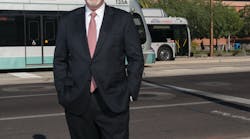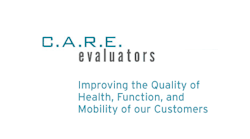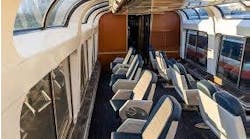Valley Metro recently modified their paratransit services in Phoenix for the East Valley dial-a-ride service, to follow the business model of brokering out the service. Valley Metro CEO Stephen Banta said he was initially skeptical because it was seen as a last resort to contract with a local cab company to provide that transit trip through a voucher program for one of their clients. “I always struggled in the previous authorities to ensure that the driver showed up and the operator that showed up had the customer services sensitivities needed for that type of client.”
Operations Director Jim Wright explained that they were looking at $35 a boarding with their paratransit service, relying on the typical cutaway bus dispatched out of the Mesa facility. Providing about 220,000 passenger trips, he said they were looking at about $10 million for paratransit.
Part of a paratransit study they did in 2007 listed one option to regionalize the service to be more cost-effective was the brokerage model.
In 2011 they put out a proposal for a broker for paratransit service and it was awarded to a local cab company, Total Transit. (That company also has a fixed-route contract for Valley Metro on the West side for some express service. ) Total Transit operates green Toyota Priuses for the service and they also broker some of the service to seven others, including a human service not-for-profit agency.
The brokered paratransit service was implemented last July and now the cost per boarding is about $23. “So we cut our price by about 33 percent,” stated Wright. “We did a passenger survey right around Christmas time. We hired a local firm to do the research and the random survey of about 600 of our customers and they love the vehicle, they love the drivers.” He added, “We were afraid of the typical, ‘They’re going to treat our customers poorly,’ and we’re getting just the opposite from that response in our survey.”
Valley Metro Communications Manager Susan Tierney said the drivers that wanted to opt in to the service went through training for ADA and sensitivity training. Wright said, “They have to meet certain criteria.”
Banta said with the research in it John Wright had done and with Total Transit and Ron Barnes, he had the added measures to ensure that the taxi operators were going to be put through the proper training program. He said, “It’s worked very, very well.
“Our ridership is continuing to grow on the paratransit service out in the East Valley. We’re able to get people to their destination in a more timely and more direct manner.” He added, “We’re also able to manage the overall cost of that delivery of service a little better because it’s more direct; it’s minimal road time.”
Communications Manager Susan Tierney said it was difficult with that whole element of change in that a lot of dial-a-ride drivers had developed a relationship with the clients and they had been driving a long time. She also mentioned the drivers were transitioned over to light rail if they wanted to apply to be a light rail operator. Wright said some of the drivers retired and some went to work for one of the subcontractors that provides the service.
During the transition process, Wright explained they met regularly for months during the startup and the marketing folks had a huge communications plan. “We had to because it was such a cultural change.”
The cities in the East Valley subsidize taxi rides for seniors and persons with disabilities. These are not necessarily ADA-certified, Wisner explained, but because there’s limited service in those communities … they go above and beyond the ADA and provide service for those individuals.
Mobility Center Offers In-Person Assessments
The customer service department needed to be moved as there wasn’t room in the new offices downtown and at the same time they were looking to build an assessment center. Valley Metro Customer Service Manager Scott Wisner said they happened to find a location, got a really great deal on the tenant improvement allowance and were then able to build out an ideal 11,000-square-foot facility two years ago.
“The sun in the Valley is incredibly hot,” Wisner stressed. “Very high humidity during those summer months.” A large indoor space for evaluations was important so they could be more efficient in their evaluation process.
“To make the facility and the process make sense, this evaluation will help us make really accurate decisions. There’s no question it’s the way to go,” Wisner said. “Once we make a person eligible, we want to try and find the conditions for alternatives, not just relying on paratransit services.”
On behalf of the region, Valley Metro manages the East and Nortwest Valley Paratransit Operations, ADA certification for the Valley and customer service for the Valley. Of the new facility, Wisner said now, “We kind of have a one-stop shop for service related to disability and seniors.”
The certification process used to be done through a paper process. Customers would mail in a 6-page application they fill out, Valley Metro staff would mail the forms to the healthcare providers asking the doctor to complete them, stating how the disability impacted the person’s ability to navigate the fixed-route system independently. “We had to go by what the doctor wrote up and then we would make a determination based on if we got it,” Wisner said.
“They have a 21-day window to fill in and return the application so lots of times we wouldn’t get the application back in time of the window,” Wisner said. “So we would have to give presumptive eligibility, which means you’re giving someone eligibility that might not be eligible.” He added, “All cities have that problem that have to do that process. Timeliness, accuracy, bias because the doctor knows them – part of the push nationally is moving away from paper process to an in-person process.”
They did a study to look at their certification process and it took about two years to get a model developed, Wisner said, to get a model developed, figure out the mixture of in-person interviews, testing, do research on a facility, find a location and then implement the new process. He said it was important to make sure they had a thorough and fair, consistent process to make an evaluation.
Valley Metro hired a contractor, C.A.R.E. evaluators, that had experience operating in-person assessments to manage that part of the process. The customer now calls the call center to inquire, they are told the process, they are sent an application, when they get the application and are ready, they call and set up the in-person appointment. “Once that call comes through,” Wisner said, “that goes to our contractor who sets up the appointment. And then they make arrangements for transportation. The contractor takes it from that point.”
The customer comes to the Mobility Center, goes through the evaluation and leaves. The contractor goes through the final report based on their observations then they send the final report to Valley Metro with a recommendation. “We review it, our staff that used to do the paper process,” Wisner said. “They make that final quality assurance check and then send out the letter.
“If we don’t agree with the assessment we go back with the evaluator and come to an agreement on the total evaluation before we send either a denial or an approval,” he said. The letter comes from Valley Metro saying whether or not the customer is certified or not certified and the reasons. “If they’re not approved, they’re able to appeal,” he explained. “We have a review panel that meets once a month to review the cases and the customers are allowed to come in or phone in and a final decision is made.”
On a typical day they will have 20 to 25 people a day that come in. Wisner said they over schedule, about 30 a day. There are two evaluators and an evaluation takes anywhere from 15 minutes to 45 minutes. The determination is made fairly quickly. The evaluators wrap up their day between 3:30 and 4:00 and then they fill out all the paperwork that same day or the next day.
“Some people self-certify out,” Wisner said. “They see there’s an in-person process and they’re either afraid of that or they realize they really don’t qualify so they’re not going to go through the problem or hassle of trying to get certified.”
He also said there was a lot of hesitation at first with the new system and people would cancel appointments. “Once they got here, people would realize it’s really not a big deal.” He continued, “There was a lot of misinformation – they’re going to poke and prod, invasion of privacy.
“What we always tell people that come in through here, we’re not trying to determine if you’re disabled or not, it’s how does your disability impact your ability to navigate the system. That’s really what we’re trying to determine.”
Wisner stressed, “We’ve got it down now that the process is really quite efficient.” He continued, “The old way was very inefficient because you were always waited on the information. We were sending out numerous faxes to the doctor … now we have to rely less and less on the doctors.”
The previous mindset, Wisner explains, was they didn’t want to make someone 100 percent eligible if they weren’t 100 percent sure, so they would give conditional eligibility. However, they weren’t enforcing it, so customers often got all the trips they wanted. With the new in-person eligibility assessment in place they’re seeing more customers fully eligible because they have the opportunity to see the person.
A Move to a Smart Card
Valley Metro developed a program called the ADA Platinum Pass. It’s an electronic smart card and the card is only charged for each usage. Valley Metro gets billed for the usage up to the cost of a monthly pass.
Wisner said, “We give them a smart card and when they use it they get free bus transportation on the system anywhere in the region. And light rail.” He continued, “The city is paying for that, only gets billed for that ride.”
It’s a stored-value card instead of the book of coupons that they used to use. People add value to the card by going to the website. If the customer puts $3 on their card they will get $10 worth of free rides. They can get up to $100 for $30 of their own out-of-pocket then they can ride, call a taxi company or a participating provider and when they go on board, they swipe their card, it deducts the fare. They swipe at the end of the trip as well which calculates the whole fare and then their balance goes down by that amount.
“What we’ve found in those cities that have done this, is that it’s a heck of a lot cheaper to put them on a taxi and subsidize the cost of it then it is to put those people on dial-a-ride or other services,” Wisner said. The average cost of a trip on the coupon program is $11 or $12 vs. $28 or $38 he explained.
“The card will just make it a more efficient way to manage it so we’re not having all those coupons.
Travel Training
Valley Metro got a grant to do travel training as another way to get some of the conditional people onto the fixed-route system. Wisner said they actually get most of the travel training clients through the ADA certification process. “They identify individuals that might be good candidates for travel training.”
The paratransit service costs $4 each way so an $8 roundtrip whereas after the travel training, they can ride on the bus or light rail for free.
In the past two years they’ve trained more than 130 individuals and more than 100 of them are considered independent travelers. Wisner stated, “You’re taking someone who was dependent on door-to-door service, which is obviously more expensive and limited to when you get picked up and someone can now ride when they want and they can ride for free.”





